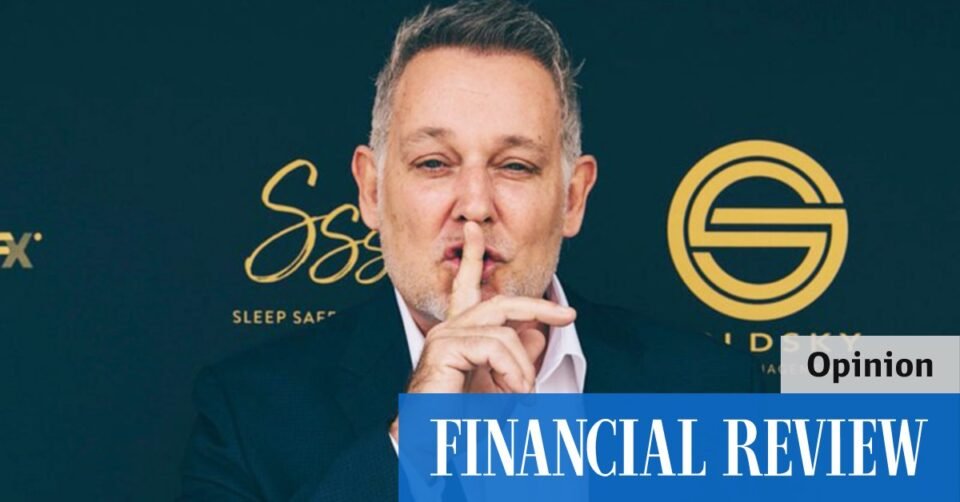Goldsky was put on my radar in April 2018. A quantitative analyst at a big broker had faced internal grief for failing to secure the award-winning quant as a client.
The fund was not short on endorsements. Sporting heroes including AFL players and coaches, Olympians, surfing legends and world champion boxers were investing their money or lending their name and fame to vouch for Goldsky.
But on its website, the fund manager could not even spell the word quantitative correctly, raising doubts it had the manpower, brain power and computing power to beat the market.
I established that contrary to the documentation it sent to investors, the service providers it referenced in its marketing materials had no association with Goldsky.
That was enough to report that all was not as it appeared. But foolishly I left it at that. I could not work out what Goldsky was actually doing wrong.
Months later, the US Securities Exchange Commission hit Grace with a lawsuit claiming he made misleading statements about how much money Goldsky managed, its returns, and its service providers.
Before reporting on the SEC action, I confronted Grace with questions. As the deadline approached, Grace said he’d lodged an injunction to prevent us publishing the article.
That turned out not to be true. In fact, in our dealings with Grace, he used a combination of stick and carrot to buy time.
“I am reaching out to you, against my lawyers’ advice, that if I keep you informed of the case with the SEC you will hold the story,” he said in an email shortly before the first report was published.

Goldksy’s office in the SALT resort, Kingscliff, as it appeared in December 2018. Jonathan Shapiro
“I’m hoping on a personal level I’m not making a mistake but trusting your integrity and am in good faith with the hope of your confidentiality … If I give you a story regarding the Goldsky issues can you guarantee I am not the source.”
Goldsky paid a $75,000 penalty to the SEC. But by the end of the year, the local corporate regulator had frozen the Goldsky funds.
That’s when I headed to Kingsclff, via the courts in Brisbane to collect documents lodged by the regulator in relation to the freezing order.
That turned out to be a treasure trove of information about Grace and Goldsky. The filing included bank statements detailing his exorbitant spending on jewellery, food, booze and plastic surgery.
There was a transcript of an interrogation conducted by ASIC officers at Grace’s office on the boardwalk of the main resort. There were emails from compliance officers basically telling ASIC Goldsky had plagiarised their documents.
Crucially, there was a list of investors and their details. But getting any of the investors to talk proved challenging. There was an air of hostility to a journalist knocking on doors. The word around town was that I was spooking them while trashing the reputation of their homegrown hero.
Grace, too, was hard to track down. He stopped responding to messages once he’d realised I was in Kingscliff. His car was parked outside his home, but the office was empty.
Eventually, I knocked on the door of his house – a villa on a cul-de-sac that can be seen from the main resort. That led to a heated exchange with his wife, who protested his innocence and my guilt in spreading panic (years later she called to offer a sincere apology for what I regarded as occupational hazard).
But there were some insightful exchanges. One was with the real estate agent who by virtue of her job seemed to know everyone. She went to a Goldsky presentation and the presence of boxer Jeff Horn almost convinced her to invest.
She changed her mind when Grace explained how Goldsky had models to predict human behavioural patterns that influenced markets.
Fear and greed could not be codified. In her view, as an agent, it was almost impossible to predict how, when and by how much sentiment would swing. There was no algorithm in the world powerful enough to model this.
Lessons learned
And so I returned to Sydney with quite a tale to tell. Inevitably, the world caught up with Ken Grace.
He was prosecuted on five counts of misconduct, and had further misadventures, including a shooting incident at a Gold Coast casino. Last week, the 58-year-old was confirmed dead after being found in a Sydney hotel room when he was due to face sentencing.
The tragic saga of Ken Grace was certainly colourful. But his crime is all too common, a garden variety Ponzi scheme in which he conned people into giving him money that he either lost or spent until he was found out. The victims – investors and those around him – suffered immensely financially and emotionally.
There will be more Ken Graces, and chances are some are actively running their schemes as we speak. But having now borne witness to a few, I have learned there are important considerations to avoid falling for them.
One is to never let your guard down. Some of the most effective schemers have raised money from within their own circles of trust such as family, religious groups or communities. Often, it’s an unwitting accomplice who has won the trust of others who lures victims.
Another lesson is to never outsource due diligence, particularly to celebrities. Top sportsmen and women deserve our respect and admiration but if they’re pitching a financial product it’s almost certainly because they’re a cheap and effective way for a promoter to buy credibility.
Even finance and business celebrities are prepared to trade their trust for a quick fee, or have fallen for such a pitch themselves. And some sources aren’t as credible as they appear. (Goldsky’s Asian hedge fund award is an example.)
The reality is that even the sharpest among us are not immune from manipulation, as much as we like to believe otherwise. It could be a friend giddy about a biotech stock, an untapped resource, or a start-up that will change the world. Sometimes the promoter believes his or her own bulls–t and on the rare occasion, the punt actually pays off.
But all too often we’re being pitched a simple transfer of wealth predicated on hope and hype. We’ll all meet our own Ken Grace one day if we haven’t already. The best we can do is make sure he doesn’t ruin us.

